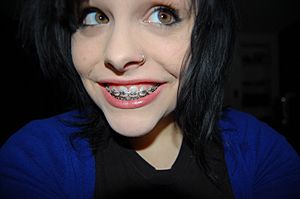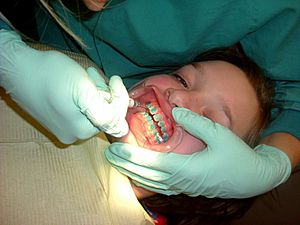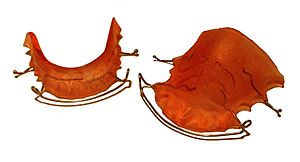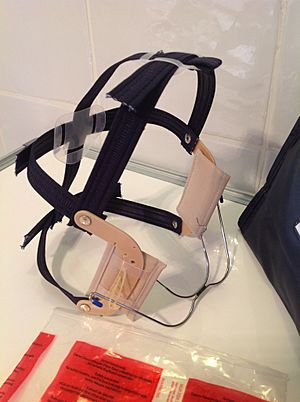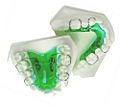Dental braces facts for kids
Dental braces are special wires and brackets that help straighten teeth. The brackets are usually glued to your permanent teeth, and wires connect them. These parts can be made of metal or other materials. An orthodontist (a dentist who specializes in straightening teeth) checks your braces regularly. They might clean them or change the wire to make it tighter.
Braces are an orthodontic tool. Their main job is to make teeth straight. They also fix problems with how your upper and lower teeth fit together, which is called your "bite." Many people have natural bite problems, but not everyone needs braces.
However, many young people get braces, even if it's not strictly needed for health. Sometimes, people get them to make their smile look better. In countries with strong economies, it's common for young people to get braces for cosmetic reasons. To make braces less noticeable, there are now clear braces. Some braces can even be placed behind the teeth, so you can't see them at all!
Contents
History of Braces
Ancient Times
People have thought about straightening teeth for a very long time. Around 400-300 BCE, ancient thinkers like Hippocrates and Aristotle looked for ways to fix dental issues. Archaeologists have found ancient mummies with metal bands around their teeth. They even used a type of cord made from animal fibers, called "catgut," to close gaps in teeth.
The Etruscans (an ancient Italian people) buried their dead with dental tools. These tools were meant to keep teeth in place even after death. A Roman tomb showed teeth tied with gold wire, like the wires used today. Even Cleopatra is said to have worn something similar. A Roman doctor, Aulus Cornelius Celsus, wrote about moving teeth with finger pressure. But for a long time, not much progress was made in braces. This was because of a lack of evidence and simple tools.
Braces in the 18th Century
Modern orthodontics really started to grow in the 1700s and 1800s. In 1728, a French dentist named Pierre Fauchard wrote a book called "The Surgeon Dentist." He is often called the "father of modern orthodontics." Fauchard used a device called a "Bandeau," which was a horseshoe-shaped iron piece. It helped to widen the dental arch.
Later, in 1754, another French dentist, Louis Bourdet, wrote The Dentist's Art. He also talked about straightening teeth. Bourdet improved the "Bandeau." He was the first dentist to suggest removing certain teeth (premolars) to make more space. This helped to fix crowded teeth and improve jaw growth.
Braces in the 19th Century
By the mid-1800s, orthodontics started to become its own science. Many important dentists helped improve braces with new tools. In 1819, Delabarre introduced the "wire crib," which was a big step for modern orthodontics. In 1843, Maynard first used gum elastics. Tucker was the first to cut rubber bands from rubber tubing in 1850.
Norman William Kingsley, a dentist and artist, wrote the first article on orthodontics in 1858. His book, Treatise on Oral Deformities, came out in 1880. Another dentist, John Nutting Farrar, wrote two books about fixing irregular teeth. He was the first to suggest using gentle force over time to move teeth.
Braces in the 20th Century
In the early 1900s, Edward Angle created a simple way to classify crooked teeth (malocclusions). His system, like Class I or Class II, is still used today. It helps dentists describe how teeth are crooked or how they fit together. Angle also greatly improved the design of orthodontic tools. He started the first orthodontics school and college. He also helped create the American Association of Orthodontists (AAO). Other new ideas included the first textbook on braces for kids in 1889. The use of rubber elastics was also improved by Calvin S. Case and Henry Albert Baker.
How Braces Work
Braces move your teeth by putting gentle force and pressure on them. There are four main parts:
- Brackets: Small pieces glued to each tooth.
- Bonding material: The special glue that holds the brackets.
- Arch wire: A wire that connects all the brackets.
- Ligature elastic: Tiny rubber bands (or O-rings) that hold the wire to the brackets.
Your teeth move when the arch wire pushes on the brackets. Sometimes, springs or rubber bands are added to push teeth in a certain direction. Braces apply constant pressure. Over time, this pressure moves your teeth into the right spots. When a tooth moves, it loosens a little. Then, new bone grows to support the tooth in its new place. This process is called bone remodeling.
Bone remodeling makes bones stronger when they are used a lot. It also makes them weaker if they don't carry a load. Bones have special cells called osteoclasts and osteoblasts that help with this. When braces push on teeth, the tissue around the tooth stretches on one side and gets squeezed on the other. This movement must be slow. If it's too fast, you could risk losing your teeth. That's why braces are worn for a year or more. Adjustments are only made every few weeks. A tooth usually moves about one millimeter per month.
Types of Braces
- Traditional metal braces are made of stainless steel. Sometimes, titanium is also used. These are the most common type of braces. They have metal brackets and small elastic (rubber band) ties. These ties hold the wire onto the brackets.
- Self-ligating braces are another common type. They don't need elastic ties. Instead, the wire goes directly through the bracket. These braces can sometimes mean shorter treatment times and less pain. They may also need fewer adjustments.
- Clear braces are a good choice if you want your braces to be less noticeable. They blend in with your natural tooth color. These brackets are usually made of ceramic or plastic. They work like metal braces. Clear elastic ties or white metal ties can be used to make them even less visible. Clear braces can also be self-ligating. However, clear braces can be more fragile than metal ones. They might also be harder to remove at the end of treatment.
- Gold-plated stainless steel braces are used for people who are allergic to nickel. Nickel is a common part of stainless steel. Some people also choose them just because they like the look of gold.
- Lingual braces are a hidden option. These custom-made braces are glued to the back of your teeth. This makes them completely invisible from the outside.
- Titanium braces look like stainless steel braces but are lighter and just as strong. They are a good option for people with nickel allergies. However, they cost more than stainless steel braces.
- Multi-Loop Edgewise Archwire (MEAW Technique) uses loops in the wire between teeth. This helps to line up teeth vertically and adjust your bite more effectively.
- Customized orthodontic systems use advanced technology. This includes 3-D imaging and special software. A robot even custom-bends the wire! Systems like SureSmile can lead to faster treatment times. They can also include lingual braces, like eBrace. These custom braces can cost more and are not available everywhere.
- Progressive, clear removable aligners like Invisalign are clear trays that you wear. They gradually move your teeth into their final spots. You get a new set of aligners every two weeks. You take them out to eat, drink, brush, and floss. These aligners are hardly noticeable. They are usually not used for very complex cases. Many orthodontists have different opinions on how well they work compared to traditional braces.
- Spring aligners are an option for simpler cases. They cost less than braces or Invisalign. They mainly align the front six top and bottom teeth.
- Smart brackets are a new idea being studied. They have a microchip that measures the forces on the tooth. The goal is to make orthodontic treatment shorter and more comfortable.
- A-braces are another new idea. They are shaped like the letter A. You can put them on, adjust them, and take them off yourself. They are not meant for sleeping. They might work as self-adjustable retainers or palate expanders.
- Partial braces cover only the four front teeth and the two very back teeth. Later, they are often upgraded to full metal wires. Kids must be at least 10 years old to get this treatment.
Getting Braces Fitted
Most orthodontic treatment in North America is done by orthodontists. These are dentists who have special training (2-3 extra years) in fixing crooked teeth and jaws.
The first step is to see if braces are right for you. The orthodontist will look at your teeth. If braces are a good idea, you'll have another appointment. At this appointment, they will take X-rays, molds, and impressions of your teeth. These records help the orthodontist plan the best treatment. Digital models of your teeth are also becoming very common.
Treatment usually lasts from six months to two and a half years. It depends on how complex your case is. In very extreme cases, jaw surgery might be needed. About two weeks before getting braces, you might need orthodontic spacers. These are small rings placed between your back teeth to create space for bands.
When it's time for braces, a special glue is put on your teeth. Then, the brackets are attached to each tooth. The glue is hardened with a light. This only takes a few seconds per tooth. Sometimes, bands are placed around your back molars. These bands help the brackets stick better, especially if you have dental fillings.
Next, an archwire is threaded through the brackets. Small elastic or metal ligatures hold the wire in place. You can choose from many colors for your elastic ligatures! The archwires are bent and tightened often to move your teeth.
Modern archwires are often made of nickel-titanium. These wires are flexible when cold. This makes them easy to put into the brackets. But when they warm up to body temperature, they stiffen. This creates a constant, gentle force on your teeth.
Sometimes, brackets have hooks, or hooks are added to the archwire. These hooks are for attaching rubber bands. The orthodontist will tell you how and when to wear these bands. They come in different sizes, colors, and strengths.
The fitting process can be a bit different for each type of brace. For clear aligners, impressions of your teeth are used to make a series of trays. These trays fit snugly over your teeth, like a mouthguard.
Sometimes, there isn't enough space in your mouth for all your teeth. There are two main ways to create more room:
- Extraction: Some teeth are removed to make space.
- Expansion: A palatal expander is used to make your palate (roof of your mouth) or dental arch wider. Expanders can be used for children and teens. For adults, jaw surgery might be needed to expand the palate, as their bones are already fused.
Some children and teenagers, and sometimes adults, need to wear a headgear appliance. This helps keep certain teeth from moving or corrects an overbite. Braces need to move teeth slowly. If teeth move too fast, you could risk losing them. That's why braces are worn for a long time, and adjustments are made every few weeks.
Braces are usually adjusted every three to six weeks. During an adjustment, the orthodontist removes the old ligatures and the archwire. They might replace or change the archwire. Then, new ligatures are put on. You can choose a new color! The adjustment might cause some discomfort, but this is normal.
After Braces Come Off
After your braces are removed, you might need a small surgery, like a fiberotomy or gum lift. This helps prepare your teeth for retainers and improves your gumline.
Retainers
To keep your teeth from moving back to their old spots, you must wear a retainer. Retainers help your teeth stay in their new positions. They also allow the tissues around your teeth to get stronger. If you don't wear your retainer as instructed, your teeth might shift back.
- Hawley retainers are common for traditional braces. They have metal wires that go around your teeth. A plastic plate fits against the roof of your mouth or under your tongue.
- Essix retainers are used for clear aligners. They are clear plastic trays that fit tightly over your teeth. They look like your clear aligners.
- Bonded retainers are wires permanently glued to the back of your teeth, usually the lower ones. Sometimes, doctors prefer not to remove these. You might need a special appointment to have them taken off.
Headgear
Headgear needs to be worn for many hours each day (usually 12-22 hours) to fix an overbite. This is typically for 12 to 18 months. The exact time depends on how severe the overbite is and how much you wear it. It's often used after the main treatment to keep your jaw and arch in place.
Orthodontic headgear usually has three main parts:
- Facebow: This is a metal arch that connects to tubes on your back molars. It extends out of your mouth and around your face. Sometimes, J-Hooks are used instead. They hook directly into your braces.
- Head cap: This part has straps that fit around your head. It connects to the facebow with elastic bands or springs. Extra straps help make it comfortable and safe.
- Attachment: This is usually made of rubber bands or springs. It connects the facebow (or J-Hooks) to the headcap. This provides the force to move your upper teeth and jaw backward.
Headgear is a very useful tool for orthodontists. It helps correct a Class II malocclusion, which is a common type of overbite. You can find more details in the article about Orthodontic headgear.
Images for kids
See also
 In Spanish: Aparatología fija para niños
In Spanish: Aparatología fija para niños


